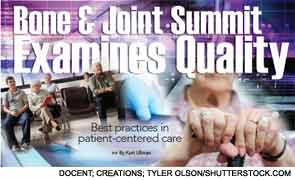
In 2001, President George W. Bush proclaimed 2002 to 2011 the Bone and Joint Decade in the U.S. The effort was deemed so successful that the U.S. Bone and Joint Initiative (USBJI) was created to continue the work.
“The USBJI is essentially an organization of organizations with most of the major stakeholders involved,” says David Pisetsky, MD, PhD, professor of medicine at Duke University Medical Center, Durham, N.C. “It is multidisciplinary in nature, including not only rheumatologists and orthopedic surgeons, but other providers, such as physiatrists, occupational and physical therapists, nurses, members of industry, payers, as well as patients, their families and advocates.”
The Initiative’s 2013 Musculoskeletal Summit was held Nov. 18–19, 2013, in Washington, D.C., and focused on best practices in patient-centered musculoskeletal care.
“The last summit, two years ago, was on value in the care of patients with these diseases,” notes Dr. Pisetsky who was one of the chairs of the meeting and spoke with The Rheumatologist following the summit. “From that basis, it was thought that to have a good understanding of value, you also have to be able to define quality. Especially in the context of a healthcare system undergoing major changes.”
Best Practices
The meeting delved into defining best practices and patient-centered care, as well as implementing best practices in clinical settings, ranging from large systems to individual practitioners. The second day discussed in more detail specific conditions, such as fracture prevention and back pain.
“This was a great opportunity for different stakeholders in musculoskeletal medicine to interact and exchange viewpoints across the field,” says Kenneth Saag, MD, MSc, Jane Knight Lowe professor of medicine at the University of Alabama at Birmingham. “There was quite a bit of cross-pollination [among] those involved, some of whom don’t necessarily communicate with each other on an ongoing basis.”

Dr. Saag participated in the session that considered how to define best practices, what evidence should be used in determining guidelines and how to establish, disseminate and implement them.
“Guidelines provide a way to summarize the state of the art for busy practitioners,” he says. “They help capture where we stand in the science behind clinical decision-making.”
Those in attendance suggested a need for additional systematic reviews to identify both existing evidence and implications for treatment. Attendees also expressed the view that quality measures should shift away from the process of care to methods for improving care quality. Among these methods are the use of information technology to generate clinically relevant cost data, identifying variables that indicate value and improving patient registries.
Importance of Care Systems

“Another important discussion concerns the importance of systems,” says Dr. Pisetsky. “Healthcare is heterogeneous in its organization. Who takes primary responsibility, for example, when a patient leaves the care of a surgeon and returns to general care?”
